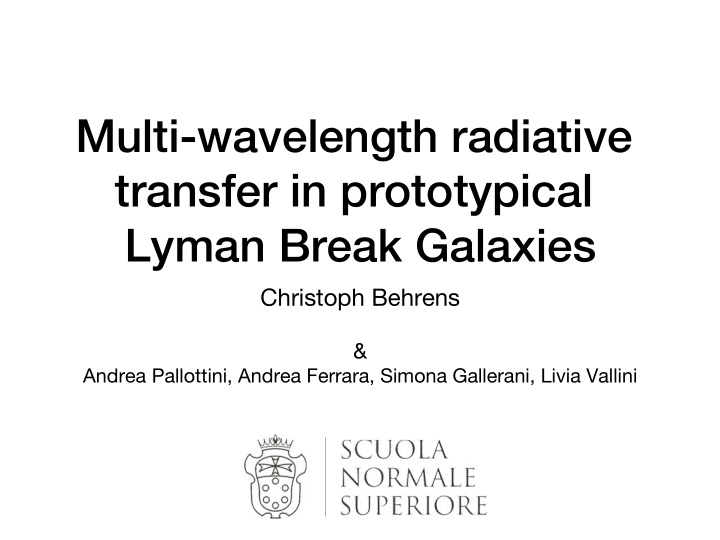



Multi-wavelength radiative transfer in prototypical Lyman Break Galaxies � Christoph Behrens & Andrea Pallottini, Andrea Ferrara, Simona Gallerani, Livia Vallini
Motivation � Key questions Key questions 1. What makes a LAE? 2. Seem to vanish at high redshift (>6) - why? Possible scenarios Possible scenarios - increase of neutral fraction in the IGM at the end of EoR - different ISM conditions, leading to smaller line shifts Requirements Requirements Hi-res cosmological hydro-simulations including Lyman-alpha and continuum radiative transfer are required
SIMULATING HIGH-Z GALAXIES Pallottini+17a ALTHAEA, a LBG @ z = 6 AMR zoom simulations Spatial res = 8 pc M h = 1.8 ✕ 10 11 M ¤ H 2 - based SFR prescription M ★ = 1.6 ✕ 10 10 M ¤ M H2 = 3 ✕ 10 9 M ¤ Updated SN feedback model Σ ★ = 15 M ¤ yr -1 kpc -2 r e = 0.6 kpc Radiation pressure (on dust) over-dense accreting Molecular/stellar disk merging clumps/satellites filaments < Z > = 0.5 Z ¤
� Radiative Transfer Setup � Radiative transfer: � - continuum + dust emission via SKIRT (e.g. Camps+15) � What ’ s an Iltis? - Lyman-alpha emission via Iltis � - CII emission from cold/warm neutral medium and molecular clouds with CLOUDY (Vallini+15) Common dust model for continuum/Lyman_alpha (Weingartner+2001)
DUST Laporte+17 ALMA BAND-7 DETECTION z = 8.38 A2744 YD4, lensed galaxy in the HFF Abel 2744 Lya line SED Fitting SFR = 20 M ¤ /yr EW=10.7 ± 2.7 Å M ★ = 2x10 9 M ¤ F α = 1.8x10 -18 cgs A V = 0.74
DUST Behrens, AF +18 Radiative transfer siMulations Simulated SED Simulated UV Map Simulated IR Map 1000-3000 A 8-1000 µm SFR ≈ 4 × higher than deduced by Laporte scattered light MAGPHYS Fit IR bright, UV optically thick ( τ V > 8) star-forming molecular complexes
Surface Brightness Maps � Lya Intrinsic Lya UV Lya Lya Luminosity Luminosity Intrinsic ~10 44 erg/s, processed ~10 40 erg/s, EW < 3 Å
The effect of inclination � Very chaotic compared to isolated galaxy simulations (e.g. Verhamme+12, Behrens+14), owing to more complex dynamics
Lya-CII line shift � Typical line shifts of ~1 Angstrom Low EW/low Lyman alpha luminosity preferentially at larger line shifts
Can we turn Althæa into a LAE? � In short: NO NO! Numerical experiment #1 Numerical experiment #1: Reduce dust mass by 10x; Increases Lyman alpha only moderately (~10 41 erg/s face-on) Numerical experiment #2 Numerical experiment #2: Remove dust from HII regions [60% of the dust removed] Boosts Lyman alpha up to 10 43 erg/s in some lines of sight. Clumpiness compensates for scarcity of dust BUT: IS IT PHYSICAL?
Conclusions � Althæa is a very resilient LBG, with EWs of order ~few Å Resilience is driven by the clumpiness of dust, not by the total mass of dust Large variations of the EW as a function of line of sight, with no clear preference for face-on directions compared to isolated simulations, owing to accretion, tidal streams, etc. Indications for a negative correlation between the CII line shift and the observed luminosity, owing to the relation between frequency diffusion and path length through a dusty medium
Recommend
More recommend